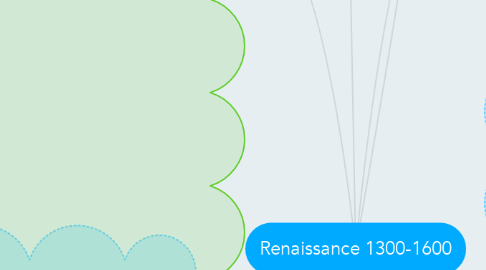
1. Advantages of Italy
1.1. Urban Centers
1.1.1. Bubonic Plague and wars lowered population
1.1.2. Merchants found it hard to expand buisness
1.1.3. Persued other interests such as art
1.2. Medici Family
1.2.1. Very wealthy family runed Florence
1.2.2. Sponsored the arts
1.3. Ancient Greek writings brought back to Rome
1.3.1. Manuscripts were studied in byzantine empire, when fell scholars fled to Italy bringing the writing with them
2. Classical and Worldly Values
2.1. Humanism: the study and depiction of human acheivements and potential
2.2. Secular beliefs, concerned with the present life and living a happy good life without worrying about after life
2.3. Patron of the Arts: someone who sponsored artists
2.4. "Renaissance man": a man who was believed to be the perfect example of renaissance ideals, a genious with the arts
2.4.1. Leonardo da Vinci
2.4.1.1. painter, sculptor, inventor, and scientist
2.4.1.2. Interested in how things worked
2.4.1.3. Used observations of natural phenomena to inspire his inventions
2.4.1.4. Known for paintings Mona Lisa and Last Supper and many more
2.4.2. Michelangelo Buonarroti
2.4.2.1. painter, a sculptor, an architect, and a poet
2.4.2.2. Inspired by human body
2.4.3. Rafael
2.4.3.1. Advanced Realism
3. Renaissance Revolutionizes art
3.1. New techniques
3.1.1. Perspective, depicting three dimentions, paintings indicating 3D
3.2. Realism
3.2.1. Ideo of making art look more "real"
4. Cities Grew Rapidly
4.1. Merchants became wealthy
4.1.1. Sponsored artists
4.2. Italy divided into city states while France and England under strong monarchs
4.2.1. These rulers also sponsored the Arts
4.2.1.1. Became shocases of renaissance
4.3. First in Flanders, rich off cloth trade
4.3.1. Became artistic center for renaissance
4.3.1.1. Jan van Eyck, first to use oil paints, developing tecniques still used today, spread to Italy
4.3.1.2. Height 1550, Pieter Bruegel, like Eyck, known for realistic paintings
5. Spread of Renaissance Ideas
5.1. France attacked northern Italy 1494
5.1.1. Artists moved to northern Europe for safety bringing the same styles and tequniques with them
5.2. Albrecht Dürer, german, traveled to Italy and apprenticed for a sculptor of gold
5.2.1. Returned to Germany where he became famous for carvings, renaissance spreads in Germany
5.3. Printing Press- Invented by Johan Gutenburg 13th century
5.3.1. First book printed: Bible
5.3.2. Soon Every city was printing books, spreading learning
6. Northern Writers
6.1. Christian Humanists
6.1.1. Desiderius Erasmus known for his writings; famous book The Praise of Folly. Poked fun at greedy merchants.
6.1.1.1. Believed in christianity of the heart
6.1.1.2. Sought to improve sociaety
6.1.2. Thomas More, wrote Utopia
6.1.2.1. Used a "perfect world" example, called utopia, to try to improve society
6.1.3. François Rabelais, wrote Gargantua and Pantagruel
6.1.3.1. Believed all humans were at their nature "good" and should just follow their instincts
6.2. Shakespeare
6.2.1. Thoutht to be greattest playwrite of all time, lived in England during "Elizibethian Age", or the renaissance under Queen Elizabeth I
6.2.1.1. Know for his tragedies Macbeth, King Lear, Hamlet, Romeo and Juliet, and the comedy A Midsummer Night’s Dream
7. Renaissance Writers change Literature
7.1. Humanism: focused on importance of humanity and human values and goodness
7.2. Francesco Petrarch, famous humanist and poet
7.3. Boccaccio known for book: Decameron, humorous, sarcastic
7.4. Niccolò Machiavelli, wrote The Prince
7.4.1. The Prince wrote about how rulers could be politically effective and keep power despite enemies through shrewdness and strength, not concerned with "goodness". Inspired rulers

